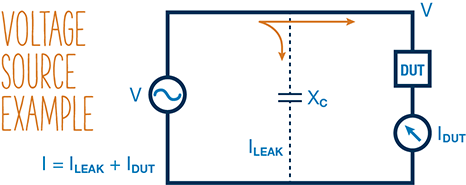When performing electrical characterization measurements with AC signals, appreciable leakage current can occur as the result of two separate phenomena:
- AC leakage current via parasitic cable capacitance
- Resulting differences between sourcing voltage and sourcing current
AC leakage current
Leakage current is the current that flows to ground through unintended paths in a circuit. For DC circuits, the impedance to ground of commonly used BNC cables is sufficiently high to limit the DC leakage to a few tens of nanoamps (depending on the voltage). However, for AC circuits, an additional path to ground exists through the parasitic cable capacitance. At high enough frequency, the capacitive impedance (Xc = 1/(2πfC)) of the cable decreases enough to allow significant current to ground. Consider a typical 6 ft long BNC cable with parasitic capacitance of 30 pF/ft operating at 10 Hz and 100 kHz. We have:
Xc (10 Hz) ~ 108 Ω = 100,000 kΩ
Xc (100 kHz) ~ 104 Ω = 10 kΩ
This is significant. For a 10 V signal, it is the difference between a leakage current of 100 nA and 1 mA. Keep in mind that this leakage current is not really lost because it ultimately returns through the shield to the power source. However, it does get accounted for differently when using an AC current source as compared to an AC voltage source.
Sourcing voltage vs. sourcing current
In an AC voltage source, the source automatically adjusts the current output to maintain the correct voltage setpoint requested by the user. When there is appreciable leakage current, the total current output by the source automatically compensates for this loss so that the current through the DUT drops the prescribed setpoint voltage, and all measurements are as expected.

Voltage source output compensates for additional leakage current to keep the drop across DUT at set voltage V
Now, consider an AC current source in the same circuit. In a current source, the voltage is adjusted to maintain the setpoint current. However, since the leakage current and the DUT current are both returning through the source, it “sees” the total current (DUT + leakage). Now the problem is evident.

Current source output is constant, and leakage path means that IDUT is less than set current
For higher frequencies (f > ~10 kHz) when the leakage current becomes significant, the current through the DUT will be less than is passing through (and reading on) the source. This behavior creates a non-intuitive condition that is commonly overlooked. Fortunately, once you identify it, you can minimize this problem by using triaxial connections and a driven guard shield.
For more information on triaxial cable connections as well as other tips on avoiding mistakes in electrical device measurement, download our free paper: “5 Measurement Pitfalls You Learned About in School But Probably Forgot.”

